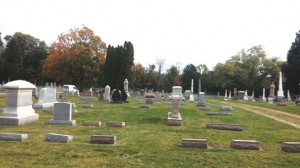“We’re coming to a graveyard, hold your breath until we pass by,” is an old admonition travelers would say to one another. The superstitious saying reflected a belief that one risked allowing an evil spirit to enter the body and possess one’s soul if the breath was not held. In Marion County, Indiana’s Warren Township there are nearly 40 cemeteries, and if motorists and passengers “held their breath” they probably would be gasping for air by the time they reached their destination.
Two cemeteries — Washington Park East and Memorial Park — along East Washington Street (the Old National Road) are probably the most recognized burial grounds. Tens of thousands of vehicles pass by these sites daily with few of the occupants, if any, turning blue. Memorial Park is the older of the two. Originally developed in 1914 as Woodland Cemetery, the first of the 28,000 burials occurred in 1917 after it had been reorganized as Memorial Park. The most notable internment is Madge Oberholtzer, the young women who was brutally assaulted by Ku Klux Klan grand dragon D. C. Stephenson. Washington Park Cemetery was intended to be the exclusive burial ground of Masons and their families, and among the first internments in October 1927 were fifteen victims of a horrific crash near East 21st Street and North Emerson Avenue involving an interurban car and a flat-bed trailer carrying Sahara Grotto partygoers.
Thousands of vehicles daily pass by a much older cemetery along East Tenth Street. Anderson Cemetery dates from the pioneer days of Warren Township and includes an older section (Herrin Cemetery) on the north side of Tenth Street beyond a low masonry wall. In the summer of 1902, ghouls violated the tranquility of Anderson Cemetery and disinterred the bodies of two young women, Stella Middleton and Glendore Gates, in the darkness of night and sold them to a medical college. After days of searching, family members recovered their loved ones and laid them once again under Anderson’s peaceful sod. The previous year, ghouls stole the body of Peter Hudson, whose remains were not recovered.
Grave stones and churches are a common association, and in Warren Township there are several church burial grounds. Probably one of the most familiar is St. John’s United Church of Christ Cemetery on the east side of German Church Road, a short distance north of Washington Street. Although the congregation no longer meets at the church, the souls sleeping in the church yard may rest at peace under the daily gaze of thousands of nameless motorists lined up from the traffic light patiently waiting their chance to pass through. In addition to this site, other old churchyards have headstones inscribed in the German language of early township residents. Although a heavy mist may sometimes envelop the narrow roadways, no “geist” of “a headless Hessian horseman” is known to be lurking around these grave yards. Still one should be respectful of the nearby sleeping spirits.
Most of the cemeteries in the township are small, pioneer burial grounds tucked along or near the roadside, and are usually found on a slight knoll amid a copse of trees. The ground bears a few weathered stones marking the resting place of sturdy men and women who carved a life out of the dense forested land and too often laid their young children under the dark earth. One of the earliest of these family plots is the Wilson-Parker Cemetery in Irvington. Located on Julian Avenue near the busy intersection of East Washington Street and Emerson Avenue, the cemetery is now a fenced-in space devoid of markers. While a few names have been recorded elsewhere, there are probably many buried here known only to God. Near the center of Warren Township down Old Trails Road, below the roar of an interstate, sleeps a hero of the American Revolution — Private John Mitchell. Another one of these quiet spots is off a busy roadway on the far eastside of the township. Looking out across a low fence into the neat landscaped housing addition of Grassy Creek is the single white shaft in Luebking Cemetery. Under Indiana law the township trustee cares for these eternal resting places which usually doesn’t go much beyond seeing that the grass is cut and the overgrowth trimmed. However in recent years under the leadership of former Warren Township trustee Jeff Bennett and his successor Vernon Brown, the pioneer cemeteries have had their monuments reset and straightened and historic cemetery markers placed. Today, descendants of Warren Township’s intrepid settlers, family historians, genealogists, and others interested in local history can visit these well-kept burial sites.
These sacred spots on All Hallows’ Eve, with leaves rustling around headstones and lengthened shadows sprawling across the ground, may not evoke the classic legends and strange tales heard elsewhere, but an odd light or a cool wisp of air may cause the passerby to draw a deep breath and to reflect for a moment on the souls within.



